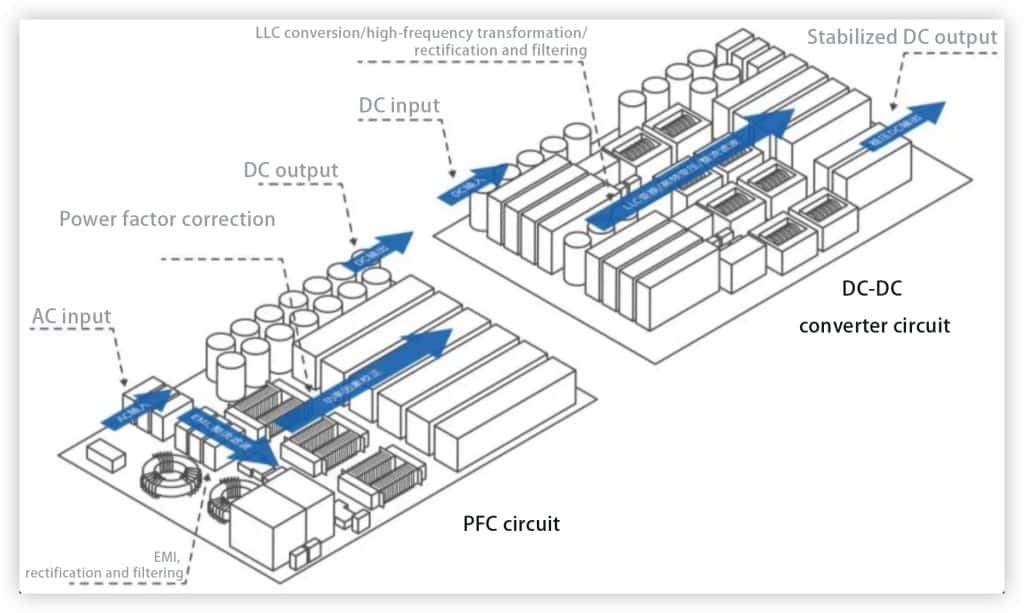The charging module is the core component of new energy vehicle DC charging equipment, serving as the fundamental unit for power conversion processes such as rectification, inversion, and filtering. Its primary function is to convert alternating current (AC) from the grid into direct current (DC) suitable for battery charging.
The performance of the charging module directly impacts the overall performance of the DC charging equipment and is closely related to charging safety, earning it the reputation as the "heart" of DC charging devices. In terms of the cost structure of DC charging piles, the charging module can account for up to 50% of the total cost.
When the charging module is in operation, the three-phase AC power is rectified by the active power factor correction (PFC) circuit and converted into DC power, which is then supplied to the DC/DC conversion circuit.

The software algorithm of the controller acts on the semiconductor power switches through the driving circuit, thereby controlling the output voltage and current of the charging module to charge the battery pack. This process involves a high technical threshold.
The charging module may encounter six common faults during use, namely module protection, module fault, uneven current sharing, communication interruption, half-load output, and failure to reach the set voltage output.
1. Charging Module Protection
Overvoltage, undervoltage, or overtemperature in the AC input of the charging module can trigger protection. If the cabinet is equipped with glass doors or is poorly ventilated, it may cause the charging module to overheat and trigger protection. High ambient temperature in the equipment room can also lead to overheating protection of the charging module.
2. Charging Module Fault
Excessive output voltage or IGBT overcurrent in the charging module will cause a module fault. Disconnect the AC power and restart the module to restore normal operation.
3. Uneven Current Sharing in the Charging Module
Failure to connect the current-sharing line may result in uneven current sharing.
Current sharing is not possible between control modules and closing modules.
4. Charging Module Communication Interruption
Incorrect address settings in the charging module will cause communication interruption. Assigning the same address to two different charging modules will also lead to communication failure with the monitoring module.
Poor or missing grounding connections in the charging module may cause communication interruption.
Under heavy load conditions, communication interruption may occur.
Incorrect serial port number settings in the monitoring module will cause communication interruption with the charging module.
5. Charging Module Half-Load Output
Some charging modules have a phase-loss half-load output protection function. Please check the AC input voltage of the charging module.
6. Charging Module Voltage Output Unable to Reach Set Voltage
Overloading the charging module will trigger current limiting, preventing the output voltage from reaching the set value.
A battery current detection error will cause the charging module to limit current, making it unable to achieve the set output voltage value.
With the increasing number of new energy vehicles in recent years, the capacity upgrades, reliability, and safety of charging modules are facing higher demands. Medium- and high-voltage power device products on the market are gradually being pushed toward newer and broader applications to meet the widespread adoption of charging modules. It is believed that with the rapid development of the industry, further standardization of charging modules is expected to become a future trend.
Another technological evolution path for charging modules is the change in cooling methods. The primary cooling method for charging modules is air cooling. However, since charging stations are used in outdoor environments, the harsh conditions often lead to particularly high failure rates in charging modules during operation. While air cooling is cost-effective, its heat dissipation performance under prolonged high-temperature operation is relatively poor.
Therefore, charging module products are continuously improving their cooling methods, transitioning from air cooling to isolated air duct cooling. With optimized air duct design, air is directed only to the heat-generating components, while components that generate little or no heat are positioned between the PCB and the casing and protected by wind barriers, thus avoiding dust contamination and corrosion. Additionally, all semiconductor power devices are hermetically installed within structurally patented components, significantly reducing failure rates and improving reliability and lifespan.
For the latest news please view Brogen’s Linkedin. For more videos please click Brogen’s Youtube.